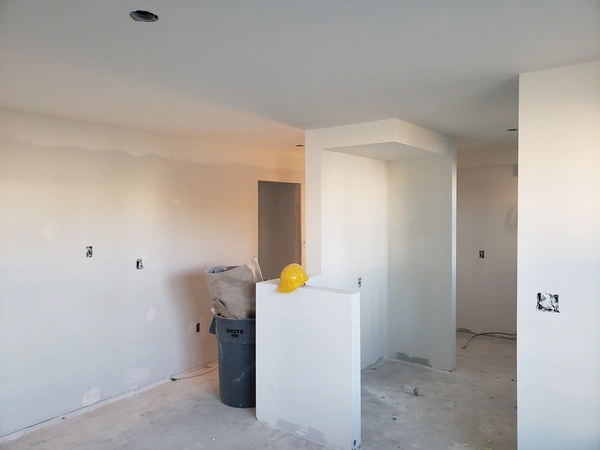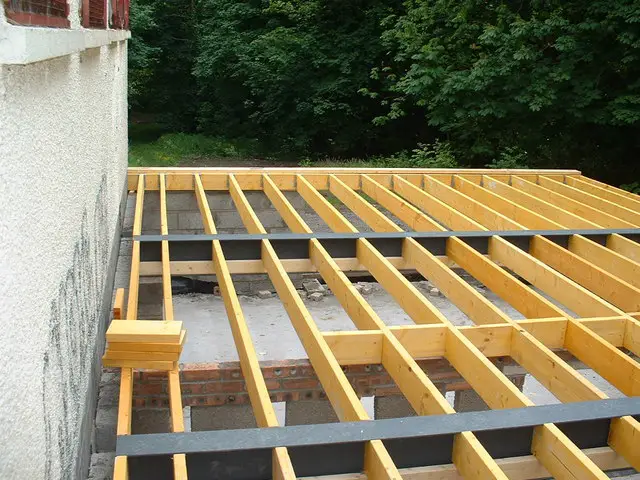When referencing walls, “finished” can mean a lot of different things under different circumstances. To avoid confusion and streamline communication across the board between architects, designers, and contractors, a standard scale for drywall finishes was created. Each level of finish on the list means something different and has a different intention or use. We’ll be breaking down the six levels of drywall finishes below so that any homeowner or someone new to the trade can “talk the talk.”
Drywall Finish Levels
There are six levels of drywall finish; levels 0-5. These levels were established by the Association of the Wall and Ceiling Industry, Ceilings & Interior Systems Construction Association, Drywall Finishing Council, inc., Gypsum Association, and the Painting Contractors Association. Below is an explanation of each level with examples of its possible use, as well as sections taken from GA-214-2021, the document that defines these levels.
Level 0
The first and most basic level of drywall finishes isn’t really a finish at all. Level “0” represents drywall that has simply been hung and screwed into place. There wouldn’t be much reason to specifically ask for a “0” level finish in a residential setting, but it could be requested in a commercial or other temporary situation.
“No taping, finishing, or accessories required.“
Level 1
A Level 1 finish indicates that joint tape has been applied to all the seams and corners of the drywall. Leaving walls at this level of finish could potentially be for a service corridor or store room- somewhere that it doesn’t matter what the walls look like. This level is also sometimes referred to as “fire taping” and is generally the minimum level required for rated wall assemblies (double check with the specific UL requirements).
“All joints and interior angles shall have tape embedded in joint compound. Excess joint compound and tool
marks are acceptable; fastener heads need not be covered.“
Level 2
Level 2 denotes walls that have received the first coat of joint compound or “mud” over the joint tape and screw holes on the surface of the wall. This level is usually sufficient for garages or workrooms.
“All joints and interior angles shall have tape embedded in joint compound and wiped with a joint knife leaving
a thin coating of joint compound over all joints and interior angles. If joint compound is applied over the body
of the tape and smoothed at the time of embedment in Level 1, it shall satisfy the conditions of this level.
Fastener heads and accessories shall be covered with one (1) coat of joint compound. Surface shall be free
of excess joint compound. Tool marks are acceptable”
Level 3
The third level of drywall finishing indicates that screw holes and joint seams have received a final coat, and been roughly smoothed out. This is usually the final level of finishing that drywall will receive if it’s going to be textured, as anything further would be a pointless effort to simply cover up with texture.
“All joints and interior angles shall have tape embedded in joint compound and shall be immediately wiped
with a joint knife leaving a thin coating of joint compound over all joints and interior angles. One (1) separate
coat of joint compound shall be applied over all joints and interior angles. Fastener heads and accessories
shall be covered with two (2) separate coats of joint compound. The surface shall be smooth and free of
tool marks.”
Level 4
Level 4 is the classic drywall finish. This is what painters expect to see when they move forward with their phase of work. The seams have all been thoroughly smoothed, and it should be indistinguishable (other than the white marks on the wall) where screw holes and tape seams were.
“All joints and interior angles shall have tape embedded in joint compound and shall be immediately wiped
with a joint knife leaving a thin coating of joint compound over all joints and interior angles. Two (2) separate
coats of joint compound shall be applied over all flat joints and one (1) separate coat of joint compound shall
be applied over interior angles. Fastener heads and accessories shall be covered with three (3) separate
coats of joint compound. The surface shall be smooth and free of tool marks.”
Level 5
Level 5 is the highest possible finish. This is not commonly an expectation from a drywall finisher- it must be specifically requested. It’s the smoothest possible finish, sometimes even requiring a full skim coat of the wall. We go further into the “how” and “why” of level 5 finishes later on.
“All joints and interior angles shall have tape embedded in joint compound and shall be immediately wiped
with a joint knife leaving a thin consistent coating of joint compound over all joints and interior angles. Two
(2) separate coats of joint compound shall be applied over all flat joints and one (1) separate coat of joint
compound shall be applied over interior angles. Fastener heads and accessories shall be covered with three
(3) separate coats of joint compound. A skim coat of joint compound or a material manufactured especially
for this purpose shall be applied to the entire surface. The surface shall be smooth and free of tool marks.“
Different Finishes for Different Areas
As mentioned above, there are varying needs for finishes, and we’ll cover a few of these distinctions below:
Bathrooms – If you’ll be covering up drywall with tile or another finish such as plastic sheeting, it isn’t really necessary to take your drywall finish past level 3.
Wainscoting and Cabinetry – If your plans call for cabinets, built-ins, wainscoting, or you know you’ll have large bookcases or other wall coverings there, let your contractor know. There’s no need to fully finish the bottom third of a wall that won’t ever be seen. This will save you time and money, and you’ll probably get a better quality product because the finishing team won’t have to waste that time.
Ceilings – While a level 4 finish is fine in most instances, level 5 may be necessary for bright rooms. Cracks and lumps are very obvious on a ceiling, and unless it’s getting textured, it’s worth the extra effort.

Level 5 Finish and Skim Coats
You’ll want to specifically request a super smooth level 5 finish under the following circumstances:
- At paperless gypsum board because the surface of the board if fairly rough
- It’s sometimes needed at abuse resistant gypsum board. The surface roughness can vary and will depend on the manufacturer. You many not need a level 5 finish if the right paint primer is used (like Tough-Hide).
- Whenever a glossy or semi-gloss paint is specified, as such a reflective paint will call attention to any imperfections
- Whenever there is strong angled lighting onto that surface from either windows or lighting fixtures
- Walls that will be used a projection screens
In a new build, getting ahead of these issues by requesting a level 5 finish will minimize the need for touchups or reapplication and repainting.
Skim coats refer to a thin layer of joint compound that is used to smooth out textured walls or repair damaged drywall. Skim coats are used for:
- Damage to the wall from wallpaper
- Major Drywall Repairs
- Old Surfaces that are generally in disrepair and scuffed up
- Unappealing surfaces (such as outdated textures)
- And of course, new drywall that requires a level 5 finish.
As a general rule of thumb, two coats for skim coating will offer the best results.
Final Thought
Communication is everything, so as you approach the phase of finishing your walls in your next project, just be sure to clearly express the end goal to ensure the perfect finish!
Sources:
https://www.americangypsum.com/sites/default/files/2022-05/ga-214-2021_17.pdf



My effort to apply sheetrock texture myself took an unexpected turn for my living room repair project. I’ve made the decision that my living room needs a sheetrock texturing service in order to be saved and given the professional appearance it deserves. For my sanity and a house that doesn’t seem like a modern art experiment gone bad, it’s a little price to pay. However, I’m also quite happy that you said that Level 5 is the best finish available, and that you have to actively ask for it from a drywall finisher rather than assuming it will be provided. It’s the smoothest finish imaginable, as you mentioned, occasionally even needing a whole wall skim layer.